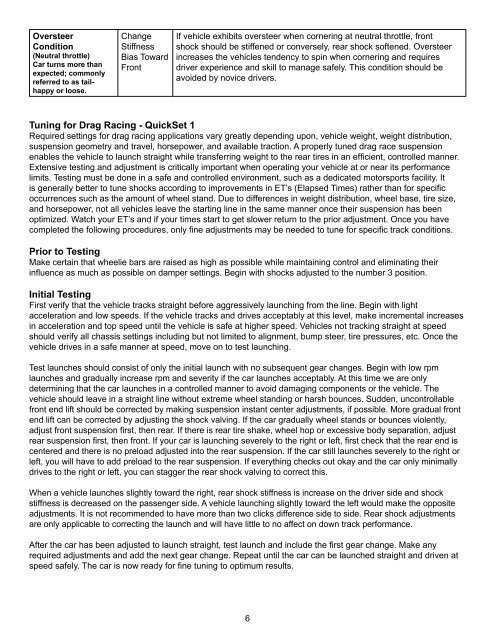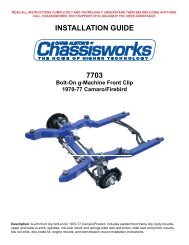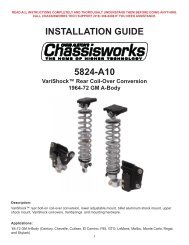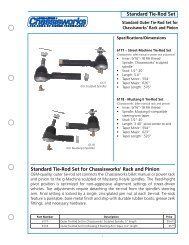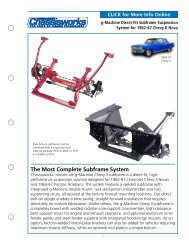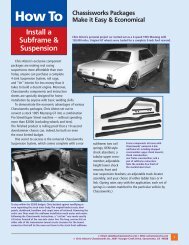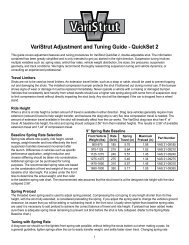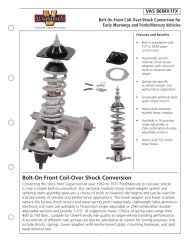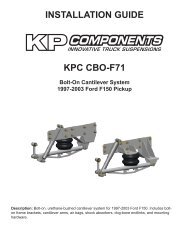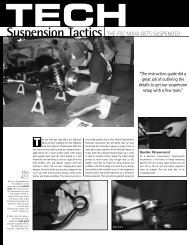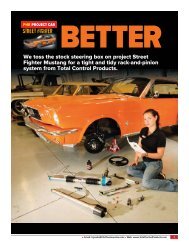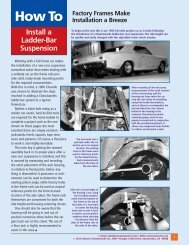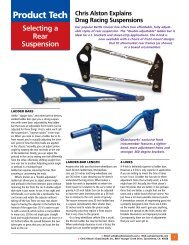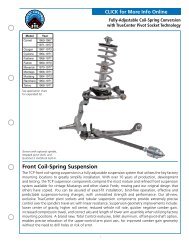Installation Instructions - Chris Alston's Chassisworks
Installation Instructions - Chris Alston's Chassisworks
Installation Instructions - Chris Alston's Chassisworks
Create successful ePaper yourself
Turn your PDF publications into a flip-book with our unique Google optimized e-Paper software.
OversteerCondition(Neutral throttle)Car turns more thanexpected; commonlyreferred to as tailhappyor loose.ChangeStiffnessBias TowardFrontIf vehicle exhibits oversteer when cornering at neutral throttle, frontshock should be stiffened or conversely, rear shock softened. Oversteerincreases the vehicles tendency to spin when cornering and requiresdriver experience and skill to manage safely. This condition should beavoided by novice drivers.Tuning for Drag Racing - QuickSet 1Required settings for drag racing applications vary greatly depending upon, vehicle weight, weight distribution,suspension geometry and travel, horsepower, and available traction. A properly tuned drag race suspensionenables the vehicle to launch straight while transferring weight to the rear tires in an efficient, controlled manner.Extensive testing and adjustment is critically important when operating your vehicle at or near its performancelimits. Testing must be done in a safe and controlled environment, such as a dedicated motorsports facility. Itis generally better to tune shocks according to improvements in ET’s (Elapsed Times) rather than for specificoccurrences such as the amount of wheel stand. Due to differences in weight distribution, wheel base, tire size,and horsepower, not all vehicles leave the starting line in the same manner once their suspension has beenoptimized. Watch your ET’s and if your times start to get slower return to the prior adjustment. Once you havecompleted the following procedures, only fine adjustments may be needed to tune for specific track conditions.Prior to TestingMake certain that wheelie bars are raised as high as possible while maintaining control and eliminating theirinfluence as much as possible on damper settings. Begin with shocks adjusted to the number 3 position.Initial TestingFirst verify that the vehicle tracks straight before aggressively launching from the line. Begin with lightacceleration and low speeds. If the vehicle tracks and drives acceptably at this level, make incremental increasesin acceleration and top speed until the vehicle is safe at higher speed. Vehicles not tracking straight at speedshould verify all chassis settings including but not limited to alignment, bump steer, tire pressures, etc. Once thevehicle drives in a safe manner at speed, move on to test launching.Test launches should consist of only the initial launch with no subsequent gear changes. Begin with low rpmlaunches and gradually increase rpm and severity if the car launches acceptably. At this time we are onlydetermining that the car launches in a controlled manner to avoid damaging components or the vehicle. Thevehicle should leave in a straight line without extreme wheel standing or harsh bounces. Sudden, uncontrollablefront end lift should be corrected by making suspension instant center adjustments, if possible. More gradual frontend lift can be corrected by adjusting the shock valving. If the car gradually wheel stands or bounces violently,adjust front suspension first, then rear. If there is rear tire shake, wheel hop or excessive body separation, adjustrear suspension first, then front. If your car is launching severely to the right or left, first check that the rear end iscentered and there is no preload adjusted into the rear suspension. If the car still launches severely to the right orleft, you will have to add preload to the rear suspension. If everything checks out okay and the car only minimallydrives to the right or left, you can stagger the rear shock valving to correct this.When a vehicle launches slightly toward the right, rear shock stiffness is increase on the driver side and shockstiffness is decreased on the passenger side. A vehicle launching slightly toward the left would make the oppositeadjustments. It is not recommended to have more than two clicks difference side to side. Rear shock adjustmentsare only applicable to correcting the launch and will have little to no affect on down track performance.After the car has been adjusted to launch straight, test launch and include the first gear change. Make anyrequired adjustments and add the next gear change. Repeat until the car can be launched straight and driven atspeed safely. The car is now ready for fine tuning to optimum results.


